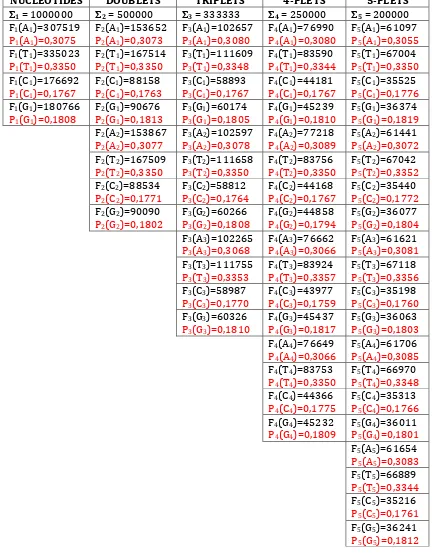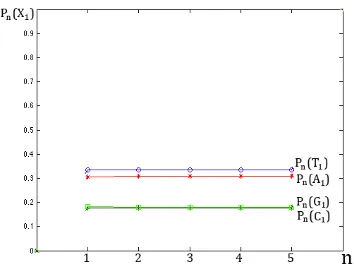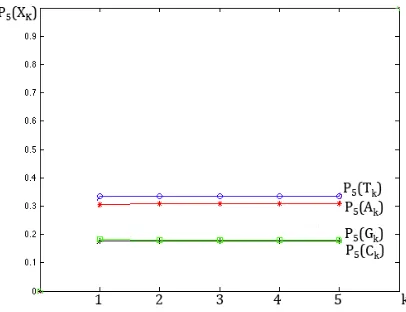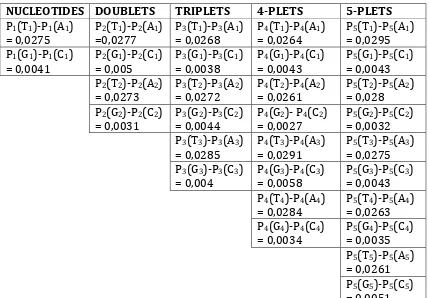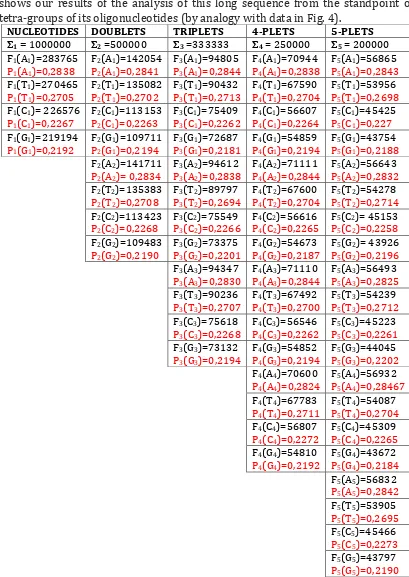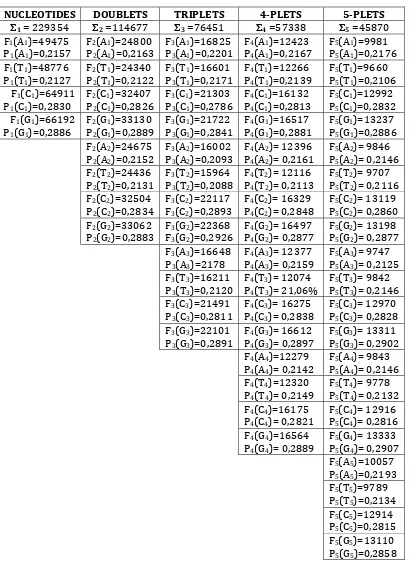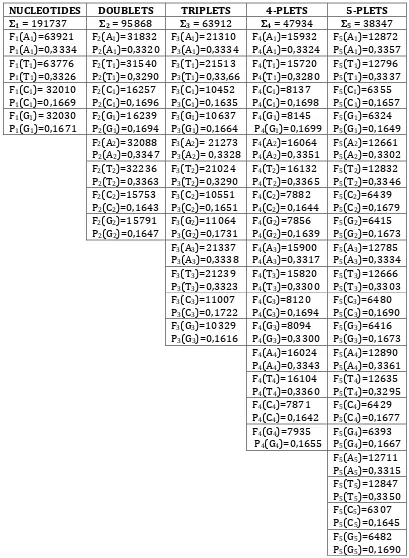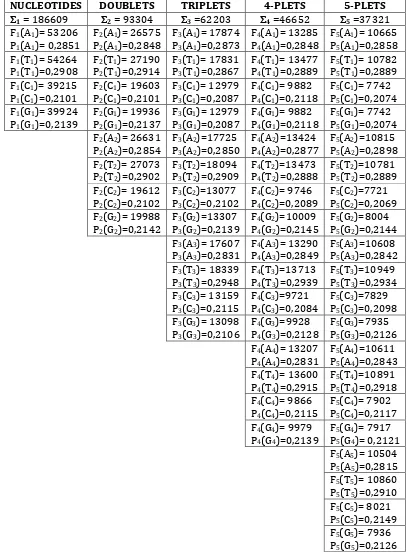The rules of long DNA‐sequences and tetra‐groups of oligonucleotides
Sergey V. Petoukhov
Head of Laboratory of Biomechanical System, Mechanical Engineering Research Institute of the Russian Academy of Sciences, Moscow
spetoukhov@gmail.com, http://petoukhov.com/
Comment: Some materials of this article were presented by the author in the keynote speech at the congress on energy and information medicine «Energiemedizin 2017» (10‐11 June 2017, Bad Soden, Germany,
http://dgeim.de/energiemedizin‐kongress‐2017/ and in the keynote speech at the international conference “Artificial Intelligence, Medical Engineering,
Education” (Moscow, Russia, 21‐23 August 2017,
http://www.ruscnconf.org/aimee2017/index.html ).
Abstract. The article is devoted to hidden symmetries in long sequences of oligonucleotides of single stranded DNA. The notions of tetra‐groups of oligonucleotides and also collective frequencies and collective probabilities of members of the tetra‐groups are introduced to study hidden tetra‐group regularities in mentioned sequences. Each of such tetra‐group contains 4 members, each of which combines 4n‐1 oligonucleotides with the same length n in
accordance with their certain attributes. Results of comparison analysis of collective probabilities of separate members of the tetra‐groups for a representative set of long nucleotide sequences are shown. These results give evidences in favor of existence of the suppositional tetra‐group rules of oligonucleotides in single stranded DNA in addition to the second Chargaff’s parity rule. An algebraic approach to model the described genetic phenomena is proposed.
Key words. Chargaff’s rules, symmetry, long nucleotide sequence, tetra‐group of oligonucleotides, probabilities, tensor product.
1. Introduction.
Two Chargaff’s parity rules are well known in genetics. They are important because they point to a kind of "grammar of biology" (these words were used by E.Chargaff in the title of his article [Chargaf, 1971]): a set of hidden rules that govern the structure of DNA. The first Chargaff's parity rule states that in any double‐stranded DNA segment, the number of occurrences (or frequencies) of adenine A and thymine T are equal, and so are frequencies of cytosine C and guanine G [Chargaff, 1951, 1971]. The rule was an important clue that J.Watson and F.Crick used to develop their model of the double helix structure of DNA.
Baldi, 2002; Bell, Forsdyke, 1999; Chargaff, 1971, 1975; Dong, Cuticchia, 2001; Forsdyke, 1995, 2002, 2006; Forsdyke, Bell, 2004; Mitchell, Bridge, 2006; Okamura, Wei, Scherer, 2007; Prabhu, 1993; Rapoport, Trifonov, 2012; Sueoka, 1995; Yamagishi, Herai, 2011]. Originally, CSPR is meant to be valid only to mononucleotide frequencies (that is quantities of monoplets) in single stranded DNA. “But, it occurs that oligonucleotide frequencies follow a generalized Chargaff’s second parity rule (GCSPR) where the frequency of an oligonucleotide is approximately equal to its complement reverse oligonucleotide frequency [Prahbu, 1993]. This is known in the literature as the Symmetry Principle” [Yamagishi, Herai, 2011, p. 2]. The work [Prahbu, 1993] shows the implementation of the Symmetry Principle in long DNA‐sequences for cases of complementary reverse n‐plets with n = 2, 3, 4, 5 at least. (In literature, a few synonimes of the term "n‐ plets" are used: n‐tuples, n‐words or n‐mers).
These parity rules, including generalized Chargaff’s second parity rule for n‐plets in long nucleotide sequences, concerns the equality of frequencies of two separate mononucleotides or two separate oligonucleotides, for example: the equality of frequencies of adenine and thymine; the equality of frequences of the doublet CA and its complement‐reverse doublet TG; the equality of the triplets CAT and its complement‐reverse triplet ATG, etc. By contrast to this, to study hidden symmetries in long sequences of oligonucleotides of single stranded DNA, we apply a comparative analysis of equalities not for frequencies of separate oligonucleotides but for aggregated frequencies (or collective frequences) of oligonucleotides from separate members of their certain tetra‐groups. Below we explain the notion of these tetra‐groups of oligonucleotides and represent new tetra‐group rules of long sequences of oligonucleotides for single stranded DNA.
2. Tetra‐groups of oligonucleotides and probabilities of tetra‐group members
Information in DNA strands is written by means of the tetra‐group of nitrogenous bases: adenine A, cytosine C, guanine G and thymine T (in RNA the tetra‐group of nitrogenous bases contains uracil U instead of thymine T). E.Chargaff has received both his parity rules by comparative analysis of frequencies of each of 4 members of this tetra‐group of mononucleotides in DNA. He and his followers studied DNA sequences as sequences of mononucleotides, frequences of separate fragments of which were compared.
Each of 4 members of such tetra‐group combines all oligonucleotides of the same length n (n‐plets), which possess the same letter at their certain position. To simplify the explanation, Fig. 1 shows the example of two tetra‐groups, which are formed and studyed by us for the analysis of long sequences of doublets.
Members of tetra‐groups
Composition of the tetra‐group of doublets with the same letter at
their first position
Composition of the tetra‐group of doublets with the same letter at
their second position
A‐member AA, AC, AG, AT AA, CA, GA, TA
T‐member TC, TA, TT, TG CT, AT, TT, GT
C‐member CC, CA, CT, CG CC, AC, TC, GC
G‐member GC, GA, GT, GG CG, AG, TG, GG
Fig. 1. Compositions of two tetra‐groups of doublets with 4 doublets in each of their 4 members.
In the first tetra‐group in Fig. 1, the complete alphabet of 16 doublets is divided into 4 subsets with 4 doublets in each by the attribute of the same letter on the first position in each of doublets. The complect of these 4 subsets is called the tetra‐group of doublets on the basis of this attribute; each of the 4 subsets is called a member of the tetra‐group; each of 4 members has its individual name with an indication of its characteristic letter (A‐member, T‐member, C‐member and G‐member). In the second tetra‐group (Fig. 1, right) the complete set of 16 doublets is divided into 4 subsets with 4 doublets in each by the attribute of the same letter on the second position in each of doublets. Fig. 2 shows three tetra‐ groups of triplets, which are used for the analysis of long sequences of triplets.
Composition of the tetra‐group of triplets with the same letter at
their 1st position
Composition of the tetra‐group of triplets with the same letter at
their 2nd position
Composition of the tetra‐group of triplets with the same letter at
their 3rd position
A‐member of the group
AAA, AAC, AAG, AAT, ATA, ATC, ATG, ATT, ACA, ACC, ACG, ACT, AGA, AGC, AGG, AGT
AAA, CAA, GAA, TAA, AAT, CAT, GAT, TAT, AAC, CAC, GAC, TAC, AAG, CAG, GAG, TAG
AAA, CAA, GAA, TAA, CTA, ATA, TTA, GTA, CCA, CAA, CTA, CGA, CGA, AGA, TGA, GGA
T‐member of the group
TAA, TAC, TAG, TAT, TTA, TTC, TTG, TTT, TCA, TCC, TCG, TCT, TGA, TGC, TGG, TGT
ATA, CTA, GTA, TTA, ATT, CTT, GTT, TTT, ATC, CTC, GTC, TTC, ATG, CTG, GTG, TTG
AAT, CAT, GAT, TAT, CTT, ATT, TTT, GTT, CCT, CAT, CTT, CGT, CGT, AGT, TGT, GGT
C‐member of the group
CAA, CAC, CAG, CAT, CTA, CTC, CTG, CTT, CCA, CCC, CCG, CCT,
ACA, CCA, GCA, TCA, ACT, CCT, GCT, TCT, ACC, CCC, GCC, TCC,
CGA, CGC, CGG, CGT ACG, CCG, GCG, TCG CGC, AGC, TGC, GGC
G‐member of the group
GAA, GAC, GAG, GAT, GTA, GTC, GTG, GTT, GCA, GCC, GCG, GCT, GGA, GGC, GGG, GGT
AGA, CGA, GGA, TGA, AGT, CGT, GGT, TGT, AGC, CGC, GGC, TGC, AGG, CGG, GGG, TGG
AAG, CAG, GAG, TAG, CTG, ATG, TTG, GTG, CCG, CAG, CTG, CGG, CGG, AGG, TGG, GGG
Fig. 2. Compositions of three tetra‐groups of triplets with 16 triplets in each of their 4 members.
In a general case of a sequence of n‐plets, the complete alphabet of 4n
n‐plets is divided into 4 subsets with 4n‐1 n‐plets in each by the attribute of the
identical letter on the chosen position inside n‐plets. In this case n tetra‐groups of n‐plets are formed:
• The tetra‐group on the basis of the attribute of the same letter on the 1st position of n‐plets;
• The tetra‐group on the basis of the attribute of the same letter on the 2nd position of n‐plets;
• …..
• The tetra‐group on the basis of the attribute of the same letter on the n‐th position of n‐plets.
We use the symbol Σn (n = 1 ,2, 3, 4,…) to denote the total quantity of n‐plets
in the considered DNA‐sequence of n‐plets; for example, the expression Σ3=100000 means that an analyzed sequence of triplets contains 100000 triplets.
Let us define notions and symbols of collective frequences and collective probabilities of members of an individual tetra‐groups in long sequences of n‐ plets, where each of n‐plets has its individual frequency (or number of its occurrences): for example, doublets have their individual frequencies F(CC), F(CA), etc.
In a long sequence of n‐plets, collective frequencies Fn(Ak), Fn(Tk), Fn(Ck) and
Fn(Gk) of 4 members of a tetra‐group of n‐plets are defined as the sum of all
individual frequencies of n‐plets belong to this member (here the index n denotes the length of n‐plets; the index k = 1, 2, 3, ..., n denotes the position of the letter in n‐plets). For example, in the case of a sequence of triplets with the letters A, C, G and G on the second positions of triplets, these collective frequencies are denoted F3(A2), F3(T2), F3(C2) and F3(G2); correspondingly the
expression F3(A2)= 50000 means that a considered sequence of triplets contains
50000 triplets with the letter A in their second positions. Fig. 3 shows appropriate definitions of collective frequencies F2(Ak), F2(Tk), F2(Ck) and F2(Gk)
for the case of sequences of doublets (here k=1,2), which are analyzed from the standpoint of both tetra‐groups from Fig. 1. Fig. 3 also shows – for the case of sequences of doublets – collective probabilities Pn(Ak), Pn(Tk), Pn(Ck) and Pn(Gk)
of separate members of tetra‐groups; in general case these probalities are defined by expressions Pn(Ak) = Fn(Ak)/Σn, Pn(Tk) = Fn(Tk)/Σn, Pn(Ck) = Fn(Ck)/Σn
and Pn(Gk) = Fn(Gk)/Σn. Below we represent the tetra‐group rules for these
of 4 members of its 4 tetra‐groups is sum of 4n‐1 individual probabilities of such
n‐plets. For example, in the case of sequence of 5‐plets, the probability P5(A1) of
the tetra‐group member, which combines 5‐plets with the letter A at their first position, contains 44=256 individual probabilities of 5‐plets: P5(A1) = P(AAAAA)
+ P(AAAAT) + P(AAAAC) +…. , etc.
F2(A1)=F(AA)+F(AC)+F(AG)+F(AT)
P2(A1) = F2(A1)/Σ2
F2(A2)=F(AA)+F(CA)+F(GA)+F(TA)
P2(A2) = F2(A2)/Σ2
F2(T1)=F(TC)+F(TA)+F(TT)+F(TG)
P2(T1) = F2(T1)/Σ2
F2(T2)=F(CT)+F(AT)+F(TT)+F(GT)
P2(T2) = F2(T2)/Σ2
F2(C1)=F(CC)+F(CA)+F(CT)+F(CG)
P2(C1) = F2(C1)/Σ2
F2(C2)=F(CC)+F(AC)+F(TC)+F(GC)
P2(C2) = F2(C2)/Σ2
F2(G1)=F(GC)+F(GA)+F(GT)+F(GG)
P2(G1) = F2(G1)/Σ2
F2(G2)=F(CG)+F(AG)+F(TG)+F(GG)
P2(G2) = F2(G2)/Σ2
Fig. 3. The definition of collective frequences Fn(Ak), Fn(Tk), Fn(Ck), Fn(Gk) and
collective propabilities Pn(Ak), Pn(Tk), Pn(Ck), Pn(Gk) for long sequences of
doublets. Left: the case of the tetra‐group of doublets with the same letter at their first position (Fig. 1). Right: the case of the tetra‐group of doublets with the same letter at their second position (Fig. 1). The symbols F(AA), F(AC), … denote individual frequencies of doublets.
Two members of any tetra‐group of n‐plets with the complementary letters on the characteristic positions are conditionally called complementary members of the appropriate tetra‐group. For example, the A‐member and the T‐member are complementary members in each of two tetra‐groups in Fig. 1. Such complementary members participate in one of the represented tetra‐group rules of long sequences of n‐plets in single stranded DNA.
3. Initial arguments in favor of tetra‐group rules of long sequences of oligonucleotides
It is generally accepted that long sequences contain more than 50 thousands or 100 thousands nucleotides [Albrecht‐Buehler, 2006; Prahbu, 1993; Rapoport, Trifonov, 2012]. In this Section we show data of analysis of two sequences of Homo sapiens chromosomes, each of which has its length of exactly one million nucleotides (only two these sequences of such length are retrieved from Entrez Search Field of Genbank by the known range operator 1000000:1000001[SLEN],
https://www.ncbi.nlm.nih.gov/Sitemap/samplerecord.html). Fig. 4 shows calculation data of the first of them from the standpoint of the proposed tetra‐ group approach: Homo sapiens chromosome 7 sequence, ENCODE region ENm012, accession NT_086368, version NT_086368.3, https://www.ncbi.nlm.nih.gov/nuccore/NT_086368.3. These data include collective frequencies Fn(Ak), Fn(Tk), Fn(Ck), Fn(Gk) and collective probabilities
Pn(Ak), Pn(Tk), Pn(Ck), Pn(Gk) of members of appropriate tetra‐groups of doublets,
Fig. 4. Collective frequencies Fn(Ak), Fn(Tk), Fn(Ck) and Fn(Gk) and also collective
probabilities Pn(Ak), Pn(Tk), Pn(Ck) and Pn(Gk) (n = 1, 2, 3, 4, 5 and k ≤ n) of
members of tetra‐groups for sequences of n‐plets, which have the same letter in their position k, in the case of the following sequence: Homo sapiens chromosome 7 sequence, 1000000 bp, encode region ENm012, accession
NT_086368, version NT_086368.3,
https://www.ncbi.nlm.nih.gov/nuccore/NT_086368.3. Collective probabilities Pn(Ak), Pn(Tk), Pn(Ck) and Pn(Gk) are marked by red for a visual comfort of their
comparison each with other.
these new rules it is assumed that the length n of considered n‐plets is much
NUCLEOTIDES DOUBLETS TRIPLETS 4‐PLETS 5‐PLETS
smaller than the length of the studied sequence. At this stage we study only long DNA‐sequences of doublets, triplets, 4‐plets and 5‐plets.
From data in Fig. 4 one can assume existence of the following tetra‐group rules for long sequences of oligonucleotides (these rules are confirmed by similar analizes of a set of other long DNA‐sequences represented below).
The first tetra‐group rule (the rule of approximate equality of the collective probabilities of n‐plets with the same letter in their fixed position k, regardless of the length n of the considered n‐plets):
• In long sequences of n‐plets of single stranded DNA, collective probabilites Pn(Xk) (X = A, T, C, G; k ≤ n; n=1,2,3,4,5,.. is not too large) of
those subset of n‐plets, which have the letter X in their position k, are approximately equal to the individual probability of the nucleotide X independently on values n.
For example, one can see from data in Fig. 4 the following:
‐ P1(A1)=0,3075 ≅ P2(A1)=0,3073 ≅ P3(A1)=0,3080 ≅ P4(A1)=0,3080 ≅ P5(A1)=0,3055;
‐ P1(T1)=0,3350 ≅ P2(T1)=0,3350 ≅ P3(T1)=0,3348 ≅ P4(T1)=0,3344 ≅ P5(T1)=0,3350;
‐ P1(C1)=0,1767 ≅ P2(C1)=0,1763 ≅ P3(C1)=0,1767 ≅ P4(C1)=0,1767 ≅ P5(C1)=0,1776;
‐ P1(G1)=0,1808 ≅ P2(G1)=0,1813 ≅ P3(G1)=0,1805 ≅ P4(G1)=0,1810 ≅ P5(G1)=0,1819.
For a more convenient vision of this rule, Fig. 5 reproduces separately data about collective frequencies Pn(Xk) (where X = A, T, C, G) from Fig. 4. Each of
tabular rows contains approximately identical values of collective probalities and – for emphasizing this fact – all its cells are marked by the same color.
Fig. 5. Collective probabilities Pn(Ak), Pn(Tk), Pn(Ck) and Pn(Gk) from Fig. 4.
The first tetra‐group rule can be graphically illustrated by a particular example in Fig. 6 for the same long DNA‐sequence (Fig. 4).
Fig. 6. The illustration of the dependence of collective probabilities Pn(A1), Pn(T1), Pn(C1)
and Pn(G1) from the length “n” of n‐plets in the case of Homo sapiens chromosome 7 sequence, 1000000 bp. Numerical data are taken from Fig. 4.
The first tetra‐group rule can be briefly expressed by the following expression (1) for any of values n =1,2, 3, 4, … under the condition of a fixed value of the index k:
P1(X1) ≅ Pn(Xk) , k ≤ n, (1)
where X means any of letters A, T, C and G; n = 1, 2, 3, 4,… is not too large.
One should remind here that in the expression (1) various collective probabilities Pn(Xk) are sum of individual probabilities of very different
quantities of n‐plets: the collective probability P2(A1) is sum of individual
probabilities of 4 doublets, the collective probability P3(A1) is sum of individual
probabilities of 16 triplets, the collective probability P4(A1) is sum of individual
probabilities of 64 tetraplets and the collective probability P5(A1) is sum of
individual probabilities of 256 pentaplets.
The second tetra‐group rule (the rule of approximate equality of collective probabilities of n‐plets with the same letter in their position k, regardless of the value of the positional index k in the considered n‐plets):
• In long sequences of n‐plets of single stranded DNA, collective probabilites Pn(Xk) (X = A, T, C, G; k ≤ n; n=1,2,3,4,5,.. is not too large) of
those subset of n‐plets, which have the letter X in their position k, are approximately equal to the individual probability of the nucleotide X independently on values k.
Fig. 5 facilitates a vision of this rule in the considered DNA‐sequence: each of tabular columns contains approximately identical values of collective probalities and – for emphasizing this fact – all such cells are marked by the same color.
For example, one can see from data in Fig. 4 the following:
‐ P5(A1)=0,3055 ≅ P5(A2)=0,3072 ≅ P5(A3)=0,3081 ≅ P5(A4)=0,3085 ≅ P5(A5)=0,3083;
‐ P5(T1)=0,3350 ≅ P5(T2)=0,3352 ≅ P5(T3)=0,3356 ≅ P5(T4)=0,3348 ≅ P5(T5)=0,3344;
‐ P5(C1)=0,1776 ≅ P5(C2)=0,1772 ≅ P5(C3)=0,1760 ≅ P5(C4)=0,1766 ≅ P5(C5)=0,1761;
The second tetra‐group rule can be graphically illustrated by a particular example in Fig. 7 for the same long DNA‐sequence in Fig. 4.
Fig. 7. The illustration of the dependence of collective probabilities P5(Ak),
P5(Tk), P5(Ck) and P5(Gk) of appropriate members of tetra‐groups from the index
k of a position of the letter in 5‐plets in the case of the sequence of 5‐plets of Homo sapiens chromosome 7 sequence, 1000000 bp. Numerical data are taken from Fig. 4.
The second tetra‐group rule can be briefly expressed by the following expression (2) for any of values k under the condition of a fixed value of a length n of n‐plets:
Pn(X1) ≅ Pn(Xk) , k ≤ n, (2)
where X means any of letters A, T, C and G; n = 1, 2, 3, 4,… is not too large.
One can see from expressions (1) and (2) that the first rule and the second rule can be jointly expressed in a brief way by the expression (3) without the mentioned conditions of a fixation of values n and k:
P1(X1) ≅ Pn(Xk) , k ≤ n, (3)
where X means any of letters A, T, C and G; n = 1, 2, 3, 4,… is not too large.
The third tetra‐group rule (the rule of approximate equality of collective probabilities of complementary members of tetra‐groups):
• in tetra‐groups of long sequences of n‐plets of single stranded DNA, collective probabilities Pn(Ak) and Pn (Tk) of the complementary A‐ and T‐
members of tetra‐groups are approximately equal to each other. The same is true for collective probabilities Pn(Ck) and Pn (Gk) of the
complementary C‐ and G‐members of tetra‐groups.
This rule is expressed by expressions (4) for any of considered values of n and k, where k ≤ n and n = 1, 2, 3, 4, … is not too large:
Pn(Ak) ≅Pn (Tk) and Pn(Ck) ≅Pn (Gk). (4)
‐ P1(A1)=0,3075 ≅ P1(T1)=0,3350; P2(A1)=0,3073 ≅ P2(T1)=0,3350;
P3(A1)=0,3080 ≅P3(T1)=0,3348; P4(A1)=0,3080 ≅ P4(T1)=0,3344;
P5(A1)=0,3055 ≅ P5(T1)=0,3350;
‐ P1(C1)=0,1767 ≅ P1(G1)=0,1808; P2(C1)=0,1763 ≅ P2(G1)=0,1813;
P3(C1)=0,1767 ≅ P3(G1)=0,1805; P4(C1)=0,1767 ≅ P4(G1)=0,1810;
P5(C1)=0,1776 ≅ P5(G1)=0,1819.
The similar situation is true for cases k = 2, 3, 4, 5 in Fig. 4.
We emphasize that approximately equal collective frequencies Fn(Ak) and
Fn(Tk) of the complementary A‐ and T‐members of tetra‐groups (as well as Fn(Ck)
and Fn(Gk) of the complementary C‐ and G‐members), which are used in
expressions (4), can differ significantly by values of individual frequences of n‐ plets in them. For example, for the sequence of doublets in Fig. 4, these collective frequencies are sum of the following individual frequencies of separate doublets:
‐ F2(A1) = F(AA)+F(AC)+F(AG)+F(AT) = 52506+23434+31500+46212,
‐ F2(T1) = F(TT)+F(TG)+F(TC)+F(TA) = 61483+ 35978+29290+40763,
‐ F2(C1) = F(CA)+F(CC)+F(CG)+F(CT) = 32721+32721+2800+33533,
‐ F2(G1) = F(GT)+F(GG)+F(GC)+F(GA) = 26281+19812+16706+27877 (5)
One can see from (5) that, for example, the individual frequency F(CG)=2800, which is used in the expression of the collective frequency F2(C1) of
the C‐member, differs by a factor of 6 from the individual frequency of the complementary doublet F(GC)=16706, which is used in the expression of the collective frequency F2(G1) of the complementary G‐member. Correspondingly
the individual probability P(CG) = F(CG)/Σ2 = 2800/500000 = 0,0056 differs by a factor of 6 from the individual probability of the complementary doublet P(GC) = F(GC)/Σ2 = 16706/500000 = 0,0334. This indicates that the described tetra‐ group rules can't be reduced to rules of individual n‐plets, but they form a special class of rules of a collective organization in oligonucleotide sequences of single stranded DNA.
The third tetra‐group rule can be considered as a generalization of the second Chargaff's parity rule, which states an approximate equality of individual frequences of complementary letters F(A)≅F(T) and F(A)≅F(T) (or probabilities P(A)≅P(T) and P(A)≅P(T)) in long nucleotide sequences of single stranded DNA. In the case of the sequence in Fig. 4, the second Chargaff's parity rule is expressed by expressions P1(A1)=0,3075 ≅ P1(T1)=0,3350 and P1(C1)=0,1767 ≅
P1(G1)=0,1808. The level of accuracy of the second Chargaff’s rule execution for
this sequence is determined by the difference of probabilities: for the probabilities of complementary letters A and T in the mononucleotide sequence, this difference is equal to P1(T1)‐P1(A1) = 0,3350‐0,3075 = 0,0275, and for the
probabilities of complementary letters C and G it is equal to P1(G1)‐P1(C1) =
0,1808‐0,1767 = 0,0041. For the analyzed sequence (Fig. 4), Fig. 8 shows that the same level of accuracy P1(T1)‐P1(A1)=0,0275 is approximately executed for all
differencies Pn(Tk)‐Pn(Ak), and that the same level of accuracy P1(G1)‐
P1(C1)=0,0041 is approximately executed for all differencies Pn(Gk)‐Pn(Ck). It
testifies that the second Chargaff's parity rule can be considered as a particular case of the third tetra‐group rule.
NUCLEOTIDES DOUBLETS TRIPLETS 4‐PLETS 5‐PLETS P1(T1)‐P1(A1)
= 0,0275
P2(T1)‐P2(A1)
=0,0277
P3(T1)‐P3(A1)
= 0,0268
P4(T1)‐P4(A1)
= 0,0264
P5(T1)‐P5(A1)
= 0,0295 P1(G1)‐P1(C1)
= 0,0041
P2(G1)‐P2(C1)
= 0,005
P3(G1)‐P3(C1)
= 0,0038
P4(G1)‐P4(C1)
= 0,0043
P5(G1)‐P5(C1)
= 0,0043 P2(T2)‐P2(A2)
= 0,0273
P3(T2)‐P3(A2)
= 0,0272
P4(T2)‐P4(A2)
= 0,0261
P5(T2)‐P5(A2)
= 0,028 P2(G2)‐P2(C2)
= 0,0031
P3(G2)‐P3(C2)
= 0,0044
P4(G2)‐ P4(C2)
= 0,0027
P5(G2)‐P5(C2)
= 0,0032 P3(T3)‐P3(A3)
= 0,0285
P4(T3)‐P4(A3)
= 0,0291
P5(T3)‐P5(A3)
= 0,0275 P3(G3)‐P3(C3)
= 0,004
P4(G3)‐P4(C3)
= 0,0058
P5(G3)‐P5(C3)
= 0,0043 P4(T4)‐P4(A4)
= 0,0284
P5(T4)‐P5(A4)
= 0,0263 P4(G4)‐P4(C4)
= 0,0034
P5(G4)‐P5(C4)
= 0,0035 P5(T5)‐P5(A5)
= 0,0261 P5(G5)‐P5(C5)
= 0,0051
Fig. 8. Levels of accuracy between values of collective propabilities (shown in Fig. 4) of complemetary members of tetra‐groups of n‐plets (n = 1, 2, 3, 4, 5) for the sequence Homo sapiens chromosome 7 sequence, encode region ENm012, accession NT_086368, version NT_086368.3, https://www.ncbi.nlm.nih.gov/nuccore/NT_086368.3. Numerical data are taken from Fig. 4.
For long DNA‐sequences of n‐plets, the described tetra‐group rules have a predictive power: knowing the collective probabilities of only two of 4 members of one of the tetra‐groups (for example, P1(A1) and P1(C1)), one can predict
approximate values of probabilities of other members of this and other tetra‐ groups on the basis of the expressions (1‐4).
Fig. 9 shows a joint representation of all three tetra‐group rules described above: sectors of the same color contain approximately the same values of collective probabilities. Each of its rings corresponds to an appropriate length “n” of n‐plets: the smallest ring corresponds to the case of doublets (in this case k = 1, 2); the next ring corresponds to the case of triplets (in this case k = 1, 2, 3), etc.
Fig. 9. The joint representation of all three tetra‐group rules: sectors of the same color contain approximately the same values of collective probabilities.
Now let us turn to the second DNA‐sequence with one million
nucleotides, which was retrieved from Entrez Search Field of Genbank by the
range operator 1000000:1000001[SLEN]: Homo sapiens chromosome 5 sequence, ENCODE region ENm002; accession NT_086358, version NT_086358.1, https://www.ncbi.nlm.nih.gov/nuccore/NT_086358.1. Fig. 10 shows our results of the analysis of this long sequence from the standpoint of tetra‐groups of its oligonucleotides (by analogy with data in Fig. 4).
Fig. 10. Collective frequencies Fn(Ak), Fn(Tk), Fn(Ck) and Fn(Gk) and also
collective probabilities Pn(Ak), Pn(Tk), Pn(Ck) and Pn(Gk) (n = 1, 2, 3, 4, 5 and k ≤
n) of members of tetra‐groups for sequences of n‐plets, which have the same letter in their position k, in the case of the following sequence: Homo sapiens chromosome 5 sequence, 1000000 bp, encode region ENm002; accession
NT_086358, version NT_086358.1,
https://www.ncbi.nlm.nih.gov/nuccore/NT_086358.1. Collective probabilities Pn(Ak), Pn(Tk), Pn(Ck) and Pn(Gk) are marked by red for a visual comfort of their
comparison each with other.
One can see from data in Fig. 10 that they satisfy the three tetra‐group rules by analogy with data in Fig. 4. Fig. 11 shows levels of accuracy between values of collective propabilities (shown in Fig. 10) of complemetary members of tetra‐groups of n‐plets for this new long DNA‐sequence. One can see that these levels of accuracy are approximately equal to the levels of accuracy in Fig. 8 for the previously considered sequence.
NUCLEOTIDES DOUBLETS TRIPLETS 4‐PLETS 5‐PLETS P1(A1)‐P1(T1) =
0,0133
P2(A1)‐P2(T1)
= 0,0139
P3(A1)‐P3(T1) =
0,0131
P4(A1)‐P4(T1)=
0,0134
P5(A1)‐P5(T1)=
0,0145 P1(C1)‐P1(G1) =
0,0075
P2(C1)‐P2(G1) =
0,0069
P3(C1)‐P3(G1) =
0,0081
P4(C1)‐P4(G1)=
0,007
P5(C1)‐P5(G1)=
0,0082 P2(A2)‐ P2(T2=
0,0126
P3(A2)‐P3(T2)=
0,0144
P4(A2)‐P4(T2)=
0,014
P5(A2)‐P5(T2)=
0,0118 P2(C2)‐P2(G2)=
0,0078
P3(C2)‐P3(G2)=
0,0065
P4(C2)‐P4(G2)=
0,0078
P5(C2)‐P5(G2)=
0,0062 P3(A3)‐ P3(T3)=
0,0123
P4(A3)‐ P4(T3)=
0,0144
P5(A3)‐P5(T3)=
0,0113 P3(C3)‐P3(G3) =
0,0074
P4(C3)‐ P4(G3) =
0,0068
P5(C3)‐P5(G3)=
0,0059 P4(A4)‐P4(T4)=
0,0113
P5(A4)‐P5(T4)=
0,0143 P4(C4)‐P4(G4)=
0,008
P5(C4)‐P5(G4)=
0,0081
P5(A5)‐P5(T5)=
0,0147
P5(C5)‐P5(G5) =
0,0083
Fig. 11. Levels of accuracy between values of collective propabilities (shown in Fig. 6) of complemetary members of tetra‐groups of n‐plets (n = 1, 2, 3, 4, 5) for the sequence Homo sapiens chromosome 5 sequence, 1000000 bp, encode region ENm002; accession NT_086358, version NT_086358.1, https://www.ncbi.nlm.nih.gov/nuccore/NT_086358.1.
3. Additional data in favor of three tetra‐group rules of long sequences of oligonucleotides
studied sequences here are taken from the article [Prahbu, 1993] to avoid a suspicion about a special choice of sequences. More precisely, we use the sequences, the length of which is which is approximately equal to 100000 nucleotides and more. For each of sequences, there are shown its title and accession data in GenBank.
NUCLEOTIDES DOUBLETS TRIPLETS 4‐PLETS 5‐PLETS
Σ1 = 229354 Σ2 =114677 Σ3 =76451 Σ4 =57338 Σ5 =45870
Fig. 12. Collective frequencies Fn(Ak), Fn(Tk), Fn(Ck), Fn(Gk) and collective
probabilties Pn(Ak), Pn(Tk), Pn(Ck) and Pn(Gk) (n = 1, 2, 3, 4, 5 and k ≤ n) of tetra‐
cytomegalovirus strain AD169 complete genome, 229354 bp, GenBank, accession X17403.1. The index k denotes a position of the letter inside n‐plets.
NUCLEOTIDES DOUBLETS TRIPLETS 4‐PLETS 5‐PLETS Σ1 = 191737 Σ2 = 95868 Σ3 = 63912 Σ4 = 47934 Σ5 = 38347
collective probabilties Pn(Ak), Pn(Tk), Pn(Ck) and Pn(Gk) (n = 1, 2, 3, 4, 5 and k ≤
.
NUCLEOTIDES DOUBLETS TRIPLETS 4‐PLETS 5‐PLETS Σ1 = 186609 Σ2 = 93304 Σ3 =62203 Σ4 =46652 Σ5 =37321
k ≤ n) of tetra‐group members in sequences of n‐plets in the case of the MPOMTCG, Marchantia paleacea isolate A 18 mitochondrion, complete genome,
186609 bp, accession M68929.1,
https://www.ncbi.nlm.nih.gov/nuccore/786182
NUCLEOTIDES DOUBLETS TRIPLETS 4‐PLETS 5‐PLETS
k ≤ n) of tetra‐group members in sequences of n‐plets in the case of the HS4B958RAJ, Epstein‐Barr virus, 184113 bp, accession M80517.1, https://www.ncbi.nlm.nih.gov/nuccore/330330
NUCLEOTIDES DOUBLETS TRIPLETS 4‐PLETS 5‐PLETS tabacum chloroplast genome DNA,155943 bp, accession Z00044.2, https://www.ncbi.nlm.nih.gov/nuccore/Z00044
NUCLEOTIDES DOUBLETS TRIPLETS 4‐PLETS 5‐PLETS
k ≤ n) of tetra‐group members in sequences of n‐plets in the case of the Oryza sativa cultivar TN1 chloroplast, complete genome, 134502 bp, accession NC_031333.1, https://www.ncbi.nlm.nih.gov/nuccore/NC_031333.1
NUCLEOTIDES DOUBLETS TRIPLETS 4‐PLETS 5‐PLETS M75136.2, https://www.ncbi.nlm.nih.gov/nuccore/519868059
NUCLEOTIDES DOUBLETS TRIPLETS 4‐PLETS 5‐PLETS herpesvirus 3 isolate 667/2005, complete genome, 124884 bp, accession JN704693.1, https://www.ncbi.nlm.nih.gov/nuccore/JN704693.1
NUCLEOTIDES DOUBLETS TRIPLETS 4‐PLETS 5‐PLETS
NUCLEOTIDES DOUBLETS TRIPLETS 4‐PLETS 5‐PLETS
k ≤ n) of tetra‐group members in sequences of n‐plets in the case of the Escherichia coli strain PSUO78 plasmid pPSUO78_1, complete sequence, 132464 bp, accession CP012113.1, https://www.ncbi.nlm.nih.gov/nuccore/CP012113.1
NUCLEOTIDES DOUBLETS TRIPLETS 4‐PLETS 5‐PLETS
Fig. 23. Collective frequencies Fn(Ak), Fn(Tk), Fn(Ck), Fn(Gk) and collective
probabilties Pn(Ak), Pn(Tk), Pn(Ck) and Pn(Gk) (n = 1, 2, 3, 4, 5 and k ≤ n) of tetra‐
NUCLEOTIDES DOUBLETS TRIPLETS 4‐PLETS 5‐PLETS
k ≤ n) of tetra‐group members in sequences of n‐plets in the following case: HUMNEUROF, Human oligodendrocyte myelin glycoprotein (OMG) exons 1‐2; neurofibromatosis 1 (NF1) exons 28‐49; ecotropic viral integration site 2B (EVI2B) exons 1‐2; ecotropic viral integration site 2A (EVI2A) exons 1‐2; adenylate kinase (AK3) exons 1‐2, 100849 bp, accession L05367.1,
NUCLEOTIDES DOUBLETS TRIPLETS 4‐PLETS 5‐PLETS
k ≤ n) of tetra‐group members in sequences of n‐plets in the case of the Podospora anserina mitochondrion, complete genome, 100314 bp, accession NC_001329.3, https://www.ncbi.nlm.nih.gov/nuccore/NC_001329.3
NUCLEOTIDES DOUBLETS TRIPLETS 4‐PLETS 5‐PLETS
k ≤ n) of tetra‐group members in sequences of n‐plets in the case of the HUMTCRADCV, Human T‐cell receptor genes (Human Tcr‐C‐delta gene, exons 1‐ 4; Tcr‐V‐delta gene, exons 1‐2; T‐cell receptor alpha (Tcr‐alpha) gene, J1‐J61 segments; and Tcr‐C‐alpha gene, exons 1‐4), 97630 bp, accession M94081.1, https://www.ncbi.nlm.nih.gov/nuccore/2627263
NUCLEOTIDES DOUBLETS TRIPLETS 4‐PLETS 5‐PLETS
k ≤ n) of tetra‐group members in sequences of n‐plets in the case of the MUSTCRA, Mouse T‐cell receptor alpha/delta chain locus, 94647 bp, accession M64239.1, https://www.ncbi.nlm.nih.gov/nuccore/201744
One can see from the data of the long DNA‐sequences in Fig. 12‐27 that all these sequences also satisfy the three tetra‐group rules.
4. The algebraic model for the three tetra‐group rules on the basis of tensor product of matrices
It is desirable to create a mathematical model of the genetic phenomena described by the phenomenologic tetra‐group rules of interrelations between individual probabilities of nucleotides and collective probabilities of oligonucleotides with the lenghts n (n=2, 3, 4, 5,…) in long sequences of single stranded DNA. A great discovery of twentieth century physics was the probabilistic nature of physical phenomena at atomic scales, described in quantum mechanics. Molecules of heredity DNA and RNA belong to the microworld of quantum mechanics and they should obey to principles of quantum mechanics. In this Section the author proposes one of possible models, which is connected with principles and formalisms of quantum mechanics and quantum informatics.
№ Binary Symbols C A G T/U
1 01 — pyrimidines 11 — purines
01 11 11 01
2 02 — amino 12 —keto
02 02 12 12
3 03 — three hydrogen bonds; 13 — two hydrogen bonds
03 13 03 13
Fig. 28. Left: the four nitrogenous bases of DNA: adenine A, guanine G, cytosine C, and thymine T. Right: three binary sub‐alphabets of the genetic alphabet on the basis of three pairs of binary‐oppositional traits or indicators.
Science does not know why the nucleotide alphabet of DNA has been created by nature from just four letters (A, T, C, G), and why just these very simple molecules were chosen for the DNA‐alphabet (out of millions of possible molecules). But science knows [Fimmel, Danielli, Strüngmann, 2013; Petoukhov, 2008; Petoukhov, He, 2009; Stambuk, 1999] that these four molecules are interrelated by means of their symmetrical peculiarities into the united molecular ensemble with its three pairs of binary‐oppositional traits or indicators (Fig. 28):
(1) Two letters are purines (A and G), and the other two are pyrimidines (C and T). From the standpoint of these binary‐oppositional traits one can denote C = T = 0, A = G = 1. From the standpoint of these traits, any of the DNA‐ sequences are represented by a corresponding binary sequence. For example, GCATGAAGT is represented by 101011110;
(2) Two letters are amino‐molecules (A and C) and the other two are keto‐ molecules (G and T). From the standpoint of these traits one can designate A = C = 0, G = T = 1. Correspondingly, the same sequence, GCATGAAGT, is represented by another binary sequence, 100110011;
Accordingly, each of the DNA‐sequences of nucleotides is the carrier of three parallel messages on three different binary languages. At the same time, these three types of binary representations form a common logical set on the basis of logical operation of modulo‐2 addition: modulo‐2 addition of any two such binary representations of the DNA‐sequence coincides with the third binary representation of the same DNA‐sequence. One can be reminded here of the rules of the bitwise modulo‐2 addition (denoted by the symbol, ⊕): 0 ⊕ 0 = 0; 0 ⊕ 1 = 1; 1 ⊕ 0 = 1; 1 ⊕ 1 = 0. The mentioned three representations of the sequence GCATGAAGT form a common logical set: for example, 101011110 ⊕ 100110011 = 001101101. (Here one can remind that the logical operation of modulo‐2 addition is actively used in quantum information).
Taking into account the phenomenologic fact that each of DNA‐letters C, A, T and G is uniquely defined by any pair of mentioned indicators (Fig. 28), these genetic letters can be represented as pairs of binary symbols, for example, from the standpoint of two first binary‐oppositional indicators. It is convenient for us for further decription to show at the first positions of each of letters its binary symbol from the second pair of binary‐oppositional indicators (the indicator "amino or keto": C=A=0, T=G=1) and at the second positions of each of letters its binary symbol from the first pair of binary‐oppostional indicators (the indicator "pyrimidine or purine": C=T=0, A=G=1). In this case the letter C is represented by the binary symbol 0201 (that is as 2‐bit binary munber), A – by the symbol 0211,
T – by the symbol 1201, G – by the symbol 1211. Using these representations of
separate letters, each of 16 doublets is represented as concatenation of the binary symbols of its letters (that is as 4‐bit binary number): for example, the doublet CC is represented as 4‐bit binary number 02010201, the doublet CA – as
4‐bit binary number 02010211, etc. By analogy, each of 64 triplets is represented
as concatenation of the binary symbols of its letters (that is as 6‐bit binary number): for example, the triplet CCC is represented as 6‐bit binary number 020102010201, the triplet CCA – as 6‐bit binary number 020102010211, etc. In
general, each of n‐plets is represented as concatenation of the binary symbols of its letters (below we will not show these indexes 2 and 1 of separate letters in binary representations of n‐plets but will remember that each of positions corresponds to its own kind of indicators from the first or from the second set of indicators in Fig. 28).
It is convenient to represent DNA‐alphabets of 4 nucleotides, 16 doublets, 64 triplets, … in a form of appropriate square tables (Fig. 29), which rows and columns are numerated by binary symbols in line with the following principle. Entries of each column are numerated by binary symbols in line with the first set of binary‐oppositional indicators in Fig. 28 (for example, the triplet CAG and all other triplets in the same column are the combination “pyrimidine‐purin‐purin” and so this column is correspondingly numerated 011). By contrast, entries of each row are numerated by binary numbers in line with the second set of indicators (for example, the same triplet CAG and all other triplets in the same row are the combination “amino‐amino‐keto” and so this row is correspondingly numerated 001). In such tables (Fig. 29), each of 4 letters, 16 doublets, 64 triplets, … takes automatically its own individual place and all components of the alphabets are arranged in a strict order.
000 001 010 011 100 101 110 111 000 CCC CCA CAC CAA ACC ACA AAC AAA 001 CCT CCG CAT CAG ACT ACG AAT AAG 010 CTC CTA CGC CGA ATC ATA AGC AGA 011 CTT CTG CGT CGG ATT ATG AGT AGG 100 TCC TCA TAC TAA GCC GCA GAC GAA 101 TCT TCG TAT TAG GCT GCG GAT GAG 110 TTC TTA TGC TGA GTC GTA GGC GGA 111 TTT TTG TGT TGG GTT GTG GGT GGG
Fig. 29. The square tables of DNA‐alphabets of 4 nucleotides, 16 doublets and 64 trilets with a strict arrangement of all components. Each of tables is constructed in line with the principle of binary numeration of its column and rows (see explanations in text).
These 3 separate genetic tables form the joint tensor family of matrices since they are interrelated by the known operation of the tensor (or Kronecker) product of matrices. By definition, under tensor multiplication of two matrices, each of entries of the first matrix is multiplied with the whole second matrix [Bellman, 1960]. The second tensor power of the (2*2)‐matrix [C, A; T, G] of 4 DNA‐letters gives automatically the matrix of 16 doublets ; the third tensor power of the matrix of the same matrix of 4 DNA‐letters gives the matrix of 64 triplets with the same strict arrangement of entries (Fig. 30).
0 1 0 C A 1 T G
00 01 10 11 00 CC CA AC AA 01 CT CG AT AG 00 CC CA AC AA 01 CT CG AT AG
Fig. 30. The tensor family of genetic matrices [C, A; T, G](n) (here tensor power n = 1, 2, 3) of DNA‐alphabets of 4 nucleotides, 16 doublets and 64 triplets. The symbol ⨂ means the tensor product.
One can see from a comparison of Fig. 30 with Fig. 29 that the tensor powers of the genetic matrix of 4 letters [C, A; T, G] produce in a new way the same square tables of the DNA‐alphabets with the same strict arrangements of alphabetic components without any mention – in this case ‐ about binary‐ oppositional traits of genetic letters C, A, T and G, which were used to construct the square tables in Fig. 29.
So, the structural organization of the system of DNA‐alphabets is connected with the algebraic operation of the tensor product. It is important since the operation of the tensor product is well known in mathematics, physics and informatics, where it gives a way of putting vector spaces together to form larger vector spaces. The following quotation speaks about the meaning of the tensor product: «This construction is crucial to understanding the quantum mechanics of multiparticle systems» [Nielsen, Chuang, 2010, p. 71]. “The state space of a composite physical systems is the tensor product of the state spaces of the component physical systems. Moreover, if we have systems numbered 1 through nm and system number i is prepared in the state �i , then the joint state of the total system is �1 ⨂ �2 ⨂…�n” [Nielsen, Chuang, 2010, p. 102].
Now we can describe our model approach, which uses the fact that sum of individual probabilities of nucleotides P(С), P(A), P(T) and P(G) in any of DNA‐ sequences is equal to unity (6):
P(C)+P(A)+P(T)+P(G) = 1 (6)
By analogy with the tensor family of genetic matrices [C, A; T, G](n) in Fig. 30,
one can consider the tensor family of genetic matrices of probabilities [P(C), P(A); P(T), P(G)](n) of nucleotides and oligonucleotides (n‐plets) in long
sequences of single strand DNA. In the kernel matrix [P(C), P(A); P(T), P(G)] we suppose that P(A) ≅ P(T) and P(C) ≅ P(G) in line with the second Chargaff's parity rule. Fig. 31 shows the example of the matrix of individual probabilities of doublets.
[P(C), P(A); P(T), P(G)](2) =
P(C)*P(C) P(C)*P(A) P(A)*P(C) P(A)*P(A)
P(C)*P(T) P(C)*P(G) P(A)*P(T P(A)*P(G)
P(T)*P(C) P(T)*P(A) P(G)*P(C) P(G)*P(A)
P(T)*P(T) P(T)*P(G) P(G)*P(T) P(G)*P(G)
Fig. 31. The genetic matrix of individual probabilities of 16 doublets, which is constructed as the second tensor power of the matrix [P(C), P(A); P(T), P(G)] of individual probabilities of nucleotides C, A, T and G.
Let us demonstrate that in each of (2*2)‐quadrants of the matrix [P(C), P(A); P(T), P(G)](2) (Fig. 31) each of its 4 entries begins with the same letter and sum of these 4 entries is equal to the individual probability of a corresponding nucleotide. Indeed, the upper left quadrant, which contains in Fig. 29‐30 all doublets with the letter C in their first position, contains in Fig. 31 probabilities
P(C)*P(C), P(C)*P(A), P(C)*P(T) and P(C)*P(G). Taking into account the equation (6), their sum (or the collective probability of all doublets with the letter C at their first position) is equal to the individual probability P(C) of the nucleotide C:
P(C)P(C)+P(C)P(A)+P(C)P(T)+P(C)P(G) = P(C)*{ P(C)+P(A)+P(T)+P(G)} = P(C).
Analogically for other (2*2)‐quadrants of the matrix [P(C), P(A); P(T), P(G)](2) (Fig. 31) we have:
P(A)P(C)+P(A)P(A)+P(A)P(T)+P(A)P(G) = P(A)*{ P(C)+P(A)+P(T)+P(G)} = P(A);
P(T)P(C)+P(T)P(A)+P(T)P(T)+P(T)P(G) = P(T)*{ P(C)+P(A)+P(T)+P(G)} = P(T);
P(G)P(C)+P(G)P(A)+P(G)P(T)+P(G)P(G) = P(G)*{ P(C)+P(A)+P(T)+P(G)} = P(G). These results simulate the expression (1) of the first tetra‐group rule for the case of collective probabilities of doublets P1(X1) ≅ P2(X1) with the following
distinction: it gives the precise equality P1(X1) = P2(X1). (The distinction between
the model precise equation P1(X1) = P2(X1) and the phenomenologic approximate
equation P1(X1) ≅ P2(X1) can be interpreted from the standpoint of chaos theory
of dynamical system). Since in line with the second Chargaff's parity rule P(A) ≅ P(T) and P(C) ≅ P(G), the model collective frequency of doublets from the A‐member of the tetra‐group of doublets with the same letter at their first position is approximately equal to the model collective frequency of doublets from the T‐member of the same tetra‐group. The similar statement is true for model collective frequencies of C‐ and –members of the same tetra‐group.
with the second letter C at their second position (see the arrangement of these doublets in Fig. 29‐30), we have from corresponding cells of the (4*4)‐matrix in Fig. 31 the following values: P(C)*P(C), P(A)*P(C), P(T)*P(C) and P(G)*P(C). Their sum (or the collective probability of all doublets with the letter C at their second position) is equal to the individual probability P(C) of the nucleotide C:
P(C)*P(C)+P(A)*P(C)+P(T)*P(C)+P(G)*P(C) ={P(C)+P(A)+P(T)+P(G)}*P(C)=P(C).
Analogically for other subsets of doublets with an identical letter in their second position we have from Fig. 29‐31 the following:
P(C)*P(A)+P(A)*P(A)+P(T)*P(A)+P(G)*P(A)={P(C)+P(A)+P(T)+P(G)}*P(A)=P(A)
P(C)*P(T)+P(A)*P(T)+P(T)*P(T)+P(G)*P(T)={P(C)+P(A)+P(T)+P(G)}*P(T)=P(T);
P(C)*P(G)+P(A)*P(G)+P(T)*P(G)+P(G)*P(G)={P(C)+P(A)+P(T)+P(G)}*P(G)=P(G)
These results simulate the expression (3) of the second tetra‐group rule for the case of collective probabilities of doublets P1(X1) ≅ P2(X2) with the
following distinction: it gives the precise equality P1(X1) = P2(X2).
A similar consideration of the matrix [P(C), P(A); P(T), P(G)](n) gives results, which simulate the tetra‐group rules for different cases of collective probabilities of n‐plets: triplets, 4‐plets, 5‐plets, etc.
The described algebraic approach for modeling phenomenologic features of molecular‐genetic systems and long sequences of single stranded DNA can be formalized in more accurate way with using typical notions, denotations and formalisms of quantum informatics from books [Holevo, 2013; Manin, 1980; Nielsen, Chuang, 2010]. The author hopes to publish results of introducing formalisms of quantum information into the named algebraic approach in genetics some later.
Some concluding remarks
the tetra‐group of doublets with the same letter at their first (second) position from Fig. 1 is identical to the set of the complement‐reverse tetra‐group of doublets with the same letter at their second (first) position in Fig. 23. This leads to the conclusion that additional tetra‐group rules connected with such complement‐reverse tetra‐groups are absent since these tetra‐groups are simple repetitions ‐ by their essential aspects ‐ of known tetra‐groups of doublets. The same is true for tetra‐groups in cases of triplets and other n‐plets.
Composition of the complement‐ reverse tetra‐group for doublets with the same letter at their second position
Composition of the complement‐ reverse tetra‐group for doublets with
the same letter at their first position
TT, GT, CT, AT TT, TG, TC, TA
GA, TA, AA, CA AG, AT, AA, AC
GG, TG, AG, CG GG, GT, GA, GC
GC, TC, AC, CC CG, CT, CA, CC
Fig. 32. Compositions of the complement‐reverse tetra‐groups, which are received by the replacement of each of doublets in Fig. 1 by its complement‐ reverse doublet.
The Chargaff's parity rules are frequently called in the literature as Symmetry Principles [Yamagishi, Herai, 2011, p. 2]. The represented tetra‐group rules give new data about hidden symmetries of long sequencies in single stranded DNA. This continues the theme of molecular‐genetic symmetries described, in particular, in our works [Petoukhov, 2008, 2011, 2012; Petoukhov, He, 2009; Petoukhov, Petukhova, 2017; Petoukhov, Svirin, 2012].
The Chargaff's rules played an important role in development of bioinformatics. We hope that the represented tetra‐group rules will be also useful for further development of bioinformatics. The study of these tetra‐group rules continues now with including, in particular, relations of the tetra‐groups of triplets with groups of amino acids and stop‐codons. In particular, the author uses the tetra‐group rules to develop a quantum information approach to model genetic phenomena.
Acknowledgments: Some results of this paper have been possible due to a long‐ term cooperation between Russian and Hungarian Academies of Sciences on the topic “Non‐linear models and symmetrologic analysis in biomechanics, bioinformatics, and the theory of self‐organizing systems”, where S.V. Petoukhov was a scientific chief from the Russian Academy of Sciences. The author is grateful to G. Darvas and I. Stepanyan for their collaboration. A special thanks is to V. Svirin for his computer program, which was made on the basis of the author’s technical tasks and descriptions, to study automatically long DNA‐ sequences (initial author’s results were obtained by a half‐manually manner).
REFERENCES
Albrecht‐Buehler G. (2006) Asymptotically increasing compliance of genomes with Chargaff's second parity rules through inversions and inverted
Albrecht‐Buehler G. (2007) Inversions and inverted transpositions as the basis for an almost universal “format” of genome sequences. Genomics, 90, 297–
Baisnee P‐F., Hampson S., Baldi P. (2002) Why are complementary DNA strands symmetric? – Bioinformatics, 18(8),1021‐33.
Bell, S. J., Forsdyke, D. R. (1999) Deviations from Chargaff's second parity rule correlate with direction of transcription ‐ J. Theo. Bio., 197, 63‐76.
Bellman, R. (1960) Introduction to Matrix Analysis. New-York: Mcgraw-Hill Book Company, Inc., 351 pp.
Chargaff, E. (1951). Structure and function of nucleic acids as cell constituents. ‐ Fed. Proc., 10, 654‐659.
Chargaff, E. (1971). Preface to a Grammar of Biology: A hundred years of nucleic acid research. ‐ Science, 172, 637‐642
Chargaff E. (1975). A fever of reason. Annu. Rev. Biochem., 44:1‐20 Dong Q., Cuticchia A. J. (2001). Compositional symmetries in complete genomes. Bioinformatics, 17, 557‐559.
Fimmel, E., Danielli A., Strüngmann L. (2013). On dichotomic classes and bijections of the genetic code. J. Theor. Biol., 336, 221–230.
Forsdyke D. R. (1995). A stem‐loop “kissing” model for the initiation of recombination and the origin of introns. Molecular Biology and Evolution, 12, 949–958.
Forsdyke D.R. (2002). Symmetry observations in long nucleotide sequences: a commentary on the discovery of Qi and Cuticchia. Bioinformatics letter, v.18, № 1, p.215‐217.
Forsdyke D. R. (2006). Evolutionary Bioinformatics. New‐York: Springer Verlag. Forsdyke D. R., Bell S. J. (2004). Purine‐loading, stem‐loops, and Chargaff's second parity rule. Applied Bioinformatics, 3, 3–8.
Holevo A. S. (2013). Quantum systems, channels, information. De Gruyter Studies in Mathematical Physics 16, 349 p.
Manin Yu. I. (1980). Computable and Uncomputable, Moscow: Sovetskoie Radio (in Russian).
Mitchell, D., Bridge, R. (2006). A test of Chargaff's second rule, BBRC, 340, 90‐ 94.
Nielsen M.A., Chuang I.L. (2010). Quantum Computation and Quantum Information. New York: Cambridge University Press.
Okamura K., Wei J., Scherer S. (2007). Evolutionary implications of inversions that have caused intra‐strand parity in DNA. Bmc Genomics, 8, 160–166.
http://www.gutenberg.org/files/39713/39713-h/39713-h.htm#Page_264 Petoukhov S.V. (2008) Matrix genetics, algebras of the genetic code, noise immunity. M., RCD, 316 p. (in Russian).
Petoukhov S.V. (2011). Matrix genetics and algebraic properties of the multi‐ level system of genetic alphabets. ‐ Neuroquantology, 2011, Vol 9, No 4, p. 60‐81, http://www.neuroquantology.com/index.php/journal/article/view/501 Petoukhov S.V. (2012) Symmetries of the genetic code, hypercomplex numbers and genetic matrices with internal complementarities. ‐ “Symmetries in genetic information and algebraic biology”, special issue of journal “Symmetry: Culture and Science” (Guest editor: S. Petoukhov), vol. 23, № 3‐4, p. 275‐301.
Petoukhov S.V., He M. (2009) Symmetrical Analysis Techniques for Genetic Systems and Bioinformatics: Advanced Patterns and Applications. Hershey, USA: IGI Global. 271 p.
Petoukhov S.V., Petukhova E.S. (2017). Symmetries in genetic systems and the concept of geno‐logical coding. ‐ Information, 2017, 8(1), 2;
doi:10.3390/info8010002, http://www.mdpi.com/2078‐2489/8/1/2/htm Petoukhov S.V., Svirin V.I. (2012). Fractal genetic nets and symmetry principles in long nucleotide sequences. ‐ Symmetry: Culture and Science, vol. 23, № 3‐4, p. 303‐322. http://petoukhov.com/PETOUKHOV_SVIRIN_FGN.pdf
Prabhu, V. V. (1993). Symmetry observation in long nucleotide sequences. Nucleic Acids Res., 21, 2797‐2800.
Rapoport A.E., Trifonov E.N. (2012): Compensatory nature of Chargaff’s second parity rule. Journal of Biomolecular Structure and Dynamics, November, 1‐13, DOI:10.1080/07391102.2012.736757
Stambuk N. (1999). Circular coding properties of gene and protein sequences. Croat. Chem. Acta, 72, 999–1008.
Sueoka N. (1995). Intrastrand parity rules of DNA base composition and usage biases of synonymous codons. Journal of Molecular Evolution, 40, 318–325. Yamagishi, M., Herai, R. (2011). Chargaff's "Grammar of Biology": New Fractal‐like Rules. http://128.84.158.119/abs/1112.1528v1

